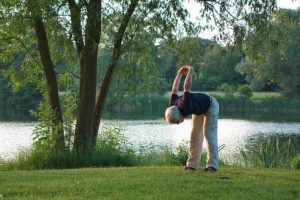How to Keep Moving as You Age
In the news this week was a story about a recent study on balance and your health. Researchers asked participants between the ages of 51 and 75 to balance on one leg for ten seconds with their head up and arms to their sides. While most participants could hold the pose for ten seconds, 20 percent of the group were unable to do so. When the researchers followed up seven years later, they found that members of the group that failed were 84% more likely to have died than those who could maintain a ten second one-legged stance.Time out: I just stepped away from my desk and timed myself balancing on one foot and then the other. I’m good— but just checking. The point of the story is that maintaining abilities like balance play a huge role in aging and longevity. Balance is a great measure of function and overall health, because falling is the number one cause of injury-related death in people who are older than 65. But it’s not just balance that can predict health in your later years. Things like your strength, flexibility and level of activity also play a role in determining your mobility, quality of life and even your memory. Over the years I have run into a number of people who say they can’t get down and up off the floor. Some were relatively young, which surprised me. As a result, I began doing something I call up-downs, which involves repeatedly getting down and up from the floor. I know, they should be called down-ups, but work with me—it’s just a name. My goal is to do ten of them each day, in the hope that if sometime in the distant future I should fall, I’ve improved my chances of being able to get up. There are a number of ways to maintain or improve your level of functioning as you age, including: 1) Walk; ideally a half hour a day. If you’re able, walking is the gold standard for staying mobile. It keeps your muscles engaged and strong, increases the circulation of blood and oxygen to your cells and may help delay onset or improve memory loss. Regular physical activity actually increases the number of cells in your hippocampus, an area in your brain related to learning and memory. In addition, scientists have found that increasing your number of daily steps from 3,000 to 7,000 reduces the risk of mortality by half for people over 60. 2) If walking’s not your thing, choose an activity—any activity—that will keep you moving. Biking is great exercise and can help you maintain your balance. Swimming helps with flexibility. Running is a good way to maintain cardio health. You get the idea—whatever works for you to stay active is a good choice. 3) Improve your balance. This is as simple as practicing the ten second one-leg test daily. You can start by holding onto the back of a chair or near a wall and work your way up to balancing without support. You can literally reduce your risk of falling by working on your balance for as little as a minute or two every day. 4) Practice Yoga or Tai Qi. Both are slow moving, intentional and can be adapted to the needs of those with limited mobility. Both Yoga and Tai Qi are a good choice to maintain physical functioning because they help increase strength, flexibility and range of motion. In addition, a regular practice of either Yoga or Tai Qi can dramatically reduce your stress. 5) Add some strength exercises to avoid frailty. There are a number of options, depending on your ability and interest. Hand weights or resistance bands can be used to strengthen both your arms and legs, or you can do wall push-ups or planks—starting with modified positions and working up. To avoid injuries or overdoing it, find a trainer or physical therapist who can set you up with the right equipment and form. 6) Stretch to maintain your flexibility. This is something that many people overlook as a part of staying fit and functional, which is puzzling because it feels so good. If you’re new to stretching, I recommend getting some professional guidance from a trainer or physical therapist. The bottom line is that there are a number of ways to avoid losing mobility and function as you age. Nowhere is the phrase “use it or lose it” more appropriate than when it comes to staying active as you get older. The key is finding activities that work best for you and doing them regularly. Your body will thank you.

In the news this week was a story about a recent study on balance and your health. Researchers asked participants between the ages of 51 and 75 to balance on one leg for ten seconds with their head up and arms to their sides. While most participants could hold the pose for ten seconds, 20  percent of the group were unable to do so. When the researchers followed up seven years later, they found that members of the group that failed were 84% more likely to have died than those who could maintain a ten second one-legged stance.
percent of the group were unable to do so. When the researchers followed up seven years later, they found that members of the group that failed were 84% more likely to have died than those who could maintain a ten second one-legged stance.
Time out: I just stepped away from my desk and timed myself balancing on one foot and then the other. I’m good— but just checking.
The point of the story is that maintaining abilities like balance play a huge role in aging and longevity. Balance is a great measure of function and overall health, because falling is the number one cause of injury-related death in people who are older than 65. But it’s not just balance that can predict health in your later years. Things like your strength, flexibility and level of activity also play a role in determining your mobility, quality of life and even your memory.
Over the years I have run into a number of people who say they can’t get down and up off the floor. Some were relatively young, which surprised me. As a result, I began doing something I call up-downs, which involves repeatedly getting down and up from the floor. I know, they should be called down-ups, but work with me—it’s just a name. My goal is to do ten of them each day, in the hope that if sometime in the distant future I should fall, I’ve improved my chances of being able to get up.
There are a number of ways to maintain or improve your level of functioning as you age, including:
1) Walk; ideally a half hour a day. If you’re able, walking is the gold standard for staying mobile. It keeps your muscles engaged and strong, increases the circulation of blood and oxygen to your cells and may help delay onset or improve memory loss. Regular physical activity actually increases the number of cells in your hippocampus, an area in your brain related to learning and memory. In addition, scientists have found that increasing your number of daily steps from 3,000 to 7,000 reduces the risk of mortality by half for people over 60.
increases the number of cells in your hippocampus, an area in your brain related to learning and memory. In addition, scientists have found that increasing your number of daily steps from 3,000 to 7,000 reduces the risk of mortality by half for people over 60.
2) If walking’s not your thing, choose an activity—any activity—that will keep you moving. Biking is great exercise and can help you maintain your balance. Swimming helps with flexibility. Running is a good way to maintain cardio health. You get the idea—whatever works for you to stay active is a good choice.
3) Improve your balance. This is as simple as practicing the ten second one-leg test daily. You can start by holding onto the back of a chair or near a wall and work your way up to balancing without support. You can literally reduce your risk of falling by working on your balance for as little as a minute or two every day.
4) Practice Yoga or Tai Qi. Both are slow moving, intentional and can be adapted to the needs of those with limited mobility. Both Yoga and Tai Qi are a good choice to maintain physical functioning because they help increase strength, flexibility and range of motion. In addition, a regular practice of either Yoga or Tai Qi can dramatically reduce your stress.
5) Add some strength exercises to avoid frailty. There are a number of options, depending on your ability and interest. Hand weights or resistance bands can be used to strengthen both your arms and legs, or you can do wall push-ups or planks—starting with modified positions and working up.  To avoid injuries or overdoing it, find a trainer or physical therapist who can set you up with the right equipment and form.
To avoid injuries or overdoing it, find a trainer or physical therapist who can set you up with the right equipment and form.
6) Stretch to maintain your flexibility. This is something that many people overlook as a part of staying fit and functional, which is puzzling because it feels so good. If you’re new to stretching, I recommend getting some professional guidance from a trainer or physical therapist.
The bottom line is that there are a number of ways to avoid losing mobility and function as you age. Nowhere is the phrase “use it or lose it” more appropriate than when it comes to staying active as you get older. The key is finding activities that work best for you and doing them regularly. Your body will thank you.












